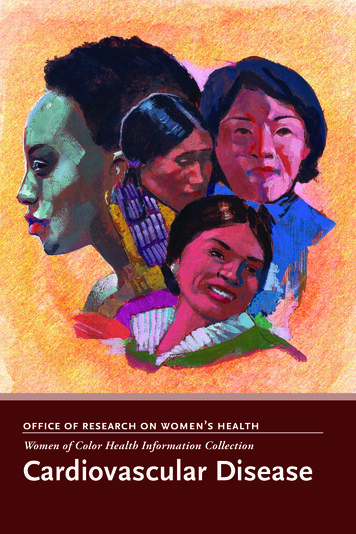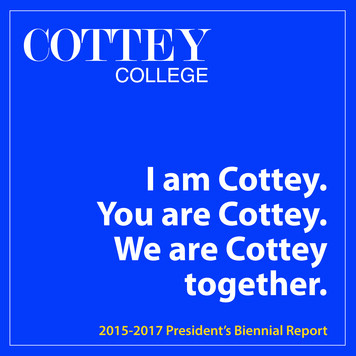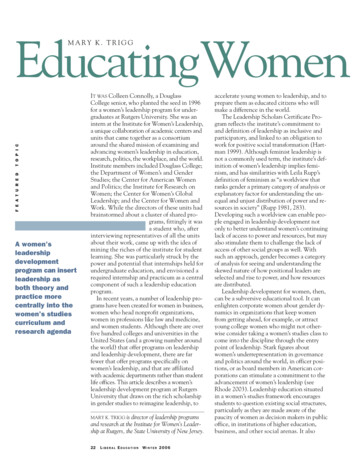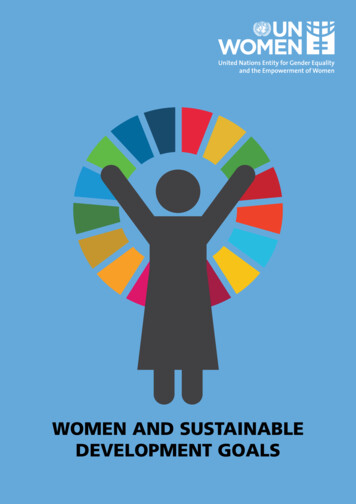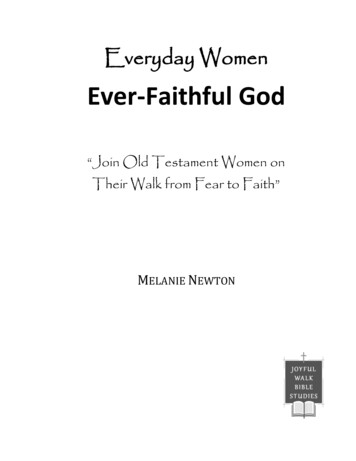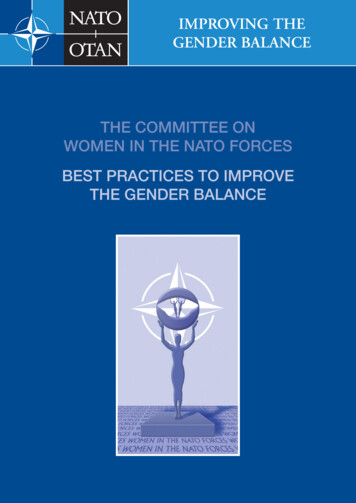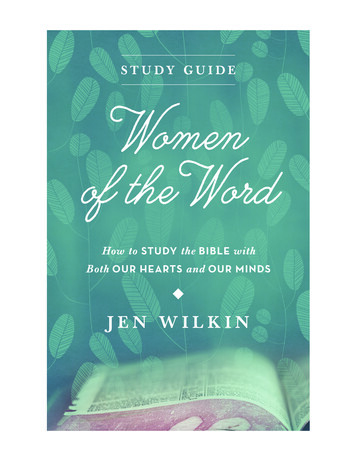
Transcription
ST U DY GU I DEW omenof the W ordHow to STUDY the BIBLE withBoth OUR HEARTS and OUR MINDSJEN WILKIN
Women of the WordHow to Study the Bible with Both Our Hearts and Our MindsJen WilkinSTUDY GUIDE FORHow to STUDY the BIBLE withBoth OUR HEARTS and OUR MINDSJEN WILKINSTUDY GUIDE PREPARED BYK R I ST I N K LUC KW H E AT O N , I L L I N O I S
Study Guide for Women of the Word: How to Study the Bible with Both Our Heartsand Our MindsCopyright 2014 by Jennifer WilkinPublished by C rossway1300 Crescent StreetWheaton, Illinois 60187All rights reserved. No part of this publication may be reproduced, stored in a retrievalsystem, or transmitted in any form by any means, electronic, mechanical, photocopy,recording, or otherwise, without the prior permission of the publisher, except asprovided for by USA copyright law.Cover design: Connie GabbertCover images: ShutterstockFirst printing 2014Printed in the United States of AmericaScripture quotations are from the ESV Bible (The Holy Bible, EnglishStandard Version ), copyright 2001 by Crossway. 2011 Text Edition.Used by permission. All rights reserved. Crossway is a publishing ministry of Good News 51
IntroductionJen relates her own journey of discovering her need to become biblically literate, and her stumbling attemptsto become so. She tells of a dawning, then growing passion to learn how to study the Bible on her own, inviting each of us to make the same journey.1. Jen describes her “church pedigree” as “mixed breed.” What is your church pedigree? How has your exposureto different churches (or lack thereof ) shaped the way you view Bible study?2. Jen tells about her realization of her own biblical illiteracy. How aware are you of your own need for greaterBible literacy? What events or experiences have raised your awareness of your need to know the Bible better?3. What experience have you had with false or poor teaching? How much of a role did ignorance of what the Biblesaid play into the teacher’s ability to spread error?3
Introduction4. On page 18, Jen describes her study method: “It intends to teach you not merely a doctrine, concept, or storyline, but a study method that will allow you to open up the Bible on your own.” How equipped do you feel to studythe Bible on your own? What tools do you currently use when you study?5. What do you think has been the greatest obstacle to your study efforts in the past? In your current life stage?What do you think could be an obstacle in the future?6. What do you most hope to gain by reading this book?4
Chapter 1Turning Things AroundJen connects how she liked to wear her tights backwards as a child with the backwards approach many ofus inadvertently take to studying Scripture. We tend to ask the Bible to speak about us first and foremost,instead of about God. We seek to feed our emotions without deepening our knowledge. Jen helps us see theerrors that result from such a backwards approach and challenges us to build Bible literacy by placing Godbefore self and mind before emotions when we study.1. What are some ways you have used the Bible as if it were a book about you? How does seeing the Bible as a bookprimarily about God, not you, change things? Read the story of the prodigal son (Luke 15:11–32). How does themeaning and application change when you see God, rather than yourself, as the focus of the parable?2. On page 29, Jen says, “For some of us, the strength of our faith is gauged by how close we feel to God at anygiven moment.” Has this ever been true of you? What is the danger of measuring your faith in this way?3. On page 30, Jen confesses that at times systematic study of the Bible felt mechanical to her. Have you felt thisway? Or have you been more put off by an emotional type of study? Should there be a balance between the two?Explain your thoughts.5
Turning Things Around4. Many of us find it difficult to take pleasure in Bible study. Chapter 1 makes a connection between pleasure andthe learning process. Describe a time when your pleasure in a relationship grew as you got to know the personbetter. To what extent have you seen the same connection in your relationship with God?5. What do you think is the connection between the two backward approaches to Bible study (seeing Scripture froma “who am I?” perspective, and thinking of our relationship with God as an emotional experience)?6. Jen says that “the heart cannot love what the mind does not know” (p. 31). Restate this idea in your own words.Why is it spiritually dangerous to claim to love God without making any effort to know him through his revealedWord?6
Chapter 2The Case for Bible LiteracyWhen it comes to “spending time in the Word,” many of us have developed some less-than-helpful habits.After offering a definition of Bible literacy, Jen asks us to examine some of these habits. She tells us thatBible literacy is worth fighting for because of the great influence women have in their homes, churches,workplaces, communities, and countries.1. When was the last time you felt uncomfortably aware of your lack of biblical knowledge? Did these feelings leadyou to take any action, and if so, what?2. What is the hardest bad habit you’ve ever had to break? How did you break it? How long did it take you?3. Jen describes six less-than-ideal approaches to studying the Bible: Xanax, Pinball, Magic 8 Ball, Personal Shopper,Telephone, and Jack Sprat. Which of these approaches have you practiced personally?7
The Case for Bible Literacy4. What is the connection between the six unhelpful approaches and our tendency to put self before God, heartbefore mind?5. Which of these six approaches is potentially the most dangerous? Which could be used in ways that are beneficial?6. Which of your circles of influence most needs you to grow in Bible literacy? Which of your relationships wouldbenefit the most if you devoted yourself to loving God with your mind?8
Chapter 3Study with PurposeThe Bible can sometimes seem like a collection of individual stories that don’t necessarily fit together intoa cohesive whole. Chapter 3 examines how to find themes from the Big Story of the Bible—the metanarrative—within the individual stories of the Bible. Jen likens this to seeing a geographical area from the skyversus the ground. She invites us to view the Bible from a bird’s-eye view.1. At the bottom of page 50 Jen defines the purpose behind Bible study. What is it? How might our personal purposein studying differ from the Bible’s intended purpose for our study?2. Based on what you learned in chapter 3, define the Big Story of the Bible in your own words.3. Next to each of the following elements of the metanarrative, note a story or passage from Scripture that youthink lends itself to telling that part of the Big Story.CreationFallRedemptionRestoration9
Study with Purpose4. Jen says on page 57, “The knowledge of God and the knowledge of self always go hand in hand.” When we lookfor self-knowledge without God as our reference point, to what or to whom do we compare ourselves? What isthe result? How does comparing ourselves to God yield a truer knowledge of self ?5. Which genre of the Bible (Narrative, Law, Poetry, Wisdom Literature, or Prophecy) have you found especiallydifficult to study in the past? How might the concept of metanarrative help you study this genre in the future?6. Which genre of the Bible (Narrative, Law, Poetry, Wisdom Literature, or Prophecy) have you found easily accessible? How might the concept of metanarrative change or deepen the way you study this genre in the future?10
Chapter 4Study with PerspectiveKnowing the historical context of a book is essential to understanding it. Because the Bible was written longago, we must learn how to occupy “a modern space while maintaining an ancient perspective” (p. 61). Chapter4 equips us to dig in to what is relevant about the history behind a book of the Bible so that we can learnhow to properly apply it in our modern setting. By exploring some basic questions about a text (Who wroteit? When was it written? To whom was it written? In what style was it written? Why was it written?), wecan significantly increase our understanding about what the text was intended to say to its original audience,giving us a much better chance of rightly understanding how it should instruct us today.1. What does it mean for you to have a sense of your own “small space” in history? How do we cultivate this sense?How does this perspective help us when studying Scripture?2. How does knowing who wrote the Chronicles of Narnia add to our understanding of how it should be read?How does knowing who wrote the Gospel of Matthew add to our understanding of how it should be read? Whatkey difference would you note between these two authors?3. Jen says, “The message of the Bible transcends its original audience, but it cannot be severed from its originalaudience” (p. 67). What does this mean?11
Study with Perspective4. Which genre (pp. 68–70) does the cultural context affect the most, making it the most difficult for us, in ourvery different culture, to understand?5. What is the pitfall to be found in the misapplication of Wisdom Literature (p. 69)? Have you ever found disillusionment this way? How does understanding the rules of the genre help you apply a proverb?6. What is the difference between using a tool like a study Bible (as described in this chapter) and taking the Personal Shopper or Telephone approach (as described in the previous chapter)?12
Chapter 5Study with PatienceWe all know that everything of value costs something. We all know that skills worth having take diligence andpractice to acquire. We recognize that learning a subject in school takes work; gaining a certification or degree requires an investment of much time and effort. Yet we seem to think that acquiring biblical knowledgewill somehow be different, that because it’s of spiritual benefit it will come to us in a more mystical, magicalway, instead of through the usual path of blood, sweat, and tears. This chapter provides some much neededencouragement to stick with it!1. Think about some of the benefits of delayed gratification across multiple areas of your life. How can similarbenefits be found in studying the Bible?2. What is the difference between simply gaining new knowledge and stretching our understanding (p. 77)?3. Do you expect to be frustrated when you study the Bible? If not, how could expecting to be frustrated help youstudy? If you do expect to be frustrated (and therefore perhaps avoid study), what kind of encouragement can youtake from this chapter?13
Study with Patience4. Had you ever thought before about how “learning aids” (like CliffsNotes) can short-circuit the learning process?Do you agree or disagree with Jen’s statement that using a shortcut is only marginally better than giving up (p. 78)?Explain your answer.5. Jen says that the feeling of being lost or confused is one way God humbles us, and is a sign that learning is aboutto take place. Can you relate to this? What truth from Scripture eluded you for a long time and then suddenlybecame clear? How would your pride have been affected if you had understood that truth immediately?6. “If I never fight for interpretation on my own, I might accept whatever interpretation I am given at face value”(p. 80). Why is this so dangerous?7. Describe the difference between viewing time in the Word as a debit account versus a savings account. Whichway have you been accustomed to seeing the time you spend in the Word? How can our stage of life affect whichvantage point we take?14
Chapter 6Study with ProcessThis is the practical heart of the book, with specific study tools and methods outlined. This is the chapter youwill turn back to over and over again as a reference point. It is chock-full of ideas and specific steps you cantake to understand, interpret, and apply the Bible. There is no formula, per se, simply a process you can useto actually get into Bible study on your own before turning to guides written by other people. This chapterputs the tools in your hands. Keep it next to your Bible for easy reference.1. What type of approach do you usually take to a project—a willy-nilly creative approach or a process-drivenbuilder approach? How does your typical approach shape the way you think about Bible study?2. Which of the comprehension tools Jen suggests (a printed copy of the text, repetitive reading, annotation, a dictionary, other translations, and outlining) do you think will be most helpful to you? Are there any you’ve alreadybeen using, or ones you’d never thought of ?3. Jen briefly discusses the difference between a translation and paraphrase of the Bible (p. 94). Why is this distinction so important?15
Study with Process4. What is the most practical, take-away step you found in this chapter? How are you going to implement it inyour own study time?5. Have you experienced the joy of drawing your own conclusion about the meaning of a text after studying it?Why is it important to consult commentaries only after seeking to find the interpretation yourself ?6. There is an idea in this chapter and throughout the book that the process of studying is valuable in and of itself—even if your paraphrase itself is bad, the exercise of crafting it increases your understanding. Are you accustomedto thinking of the process this way? Why or why not?7. On page 100, Jen describes Bible study as a process of creating and maintaining an orderly, beautiful place withinour hearts where the Lord may dwell, similar to the process of building the tabernacle. How does this descriptiongive you a new view of study? How does it encourage or inspire you?16
Chapter 7Study with PrayerPray. Why is this simple, essential practice so easy to overlook? We rush through it, do it as an afterthought,or even straight-up forget. Jen suggests that we weave prayer throughout our study time, rather than just useit as an opening or closing “nod to God.” The simple and practical prayer thoughts outlined in this chapterare both freeing and convicting. Get out your highlighter.1. “Without prayer, our study is nothing but an intellectual pursuit. With prayer, it is a means of communing withthe Lord. Prayer is what changes our study from the pursuit of knowledge to the pursuit of God himself ” (p. 103).What does the absence of prayer in our study time reveal about what we really think is true about learning theBible?2. “Pray from a sincere desire, not from a sense of obligation to ‘do things the right way’” (p. 104). What can youdo if all you have is the sense of obligation? How can you grow in sincere desire?3. Which of the PARTs of prayer do you underutilize? Which of the prayer suggestions did you find most helpful?17
Study with Prayer4. What prayer suggestions did you find challenging and convicting? What one did you find encouraging and freeing? Did any of the specific prayer requests Jen suggested surprise you?5. Knowing that the Holy Spirit speaks to us and convicts us through Scripture whether we ask him to or notcould rob us of the motive to ask him. What do we have to gain by inviting his presence and seeking his blessingon our study?18
Chapter 8Pulling It All TogetherThis chapter walks us through the methods and ideas presented in the previous chapters, showing practically how they work with a text. It’s one thing to be told how to catch a fish and quite another to be shown.Because the tools may be new to many, it’s helpful to see what all these methods look like in practice.1. Jen suggests a supply list on page 111. Did any of the supplies seem surprising or unnecessary? What would youadd to the list?2. Jen describes the archaeological questions as a means to “get into the skin” of the author and his original hearers. In the example of the book of James, how might knowing that James was the brother of Jesus affect the wayyou read the letter? How might knowing the fact that he was martyred affect the way that you read his words onremaining steadfast?3. The comprehension phase will take a lot of time. How will you combat your frustration/impatience at this stage?Which method in the comprehension process do you think will be most enjoyable or rewarding? Which will testyour patience the most?19
Pulling It All Together4. Why do you think Jen specifies cross-references, paraphrasing, and commentary in that order in the interpretation stage (pp. 117–19)? What difference does the order make?5. What other types of application, besides God-centered application, do we tend to jump to? Why do we need tostart with God-centered applications?6. “Fight for your own personal contact with the text before looking to other sources for help” (p. 123). Why is thisso important when we study Scripture?7. What are some benefits of sharing your study with a group? Which one appeals to you the most? Which do youneed the most?20
Chapter 9Help for TeachersTeaching Holy Scripture is a high calling, and it requires a great deal from those who would undertake it. Inthis chapter, Jen gives practical help for those who are wondering if they could or should pursue a potentialcall to teach. She balances encouragement to heed the calling with warnings against entering into teachinglightly. Whether you think you might be a teacher or not, this chapter gives a peek “behind the curtain” thatis helpful to both teacher and student.1. Jen states on pages 131–32, “The teacher is not the one with greater knowledge but with a greater natural curiosity to pursue the questions we all encounter. . . . Her enthusiasm for discovery becomes contagious among herstudents.” Do you think this is true? How have you experienced this as a student?2. Jen encourages teachers to embrace the challenging questions that arise through study and teaching. Why doyou think this is important? Why do teachers shy away from the hard questions? What can be gained from addressing them head-on?3. Jen says on page 139, “Teaching a passage to those who have studied it is far more demanding than teaching oneto those who have not.” Why is this the case? How does studying a passage before hearing teaching on it changethe listening and learning experience for you?21
Help for Teachers4. If it is so much harder to teach an audience who has studied the passage ahead of time, what should motivateteachers to encourage their students to pre-study? Give several possible motives.5. What stage(s) of study (comprehension, interpretation, application) should the student be encouraged to tacklebefore a teaching time? Ideally, what stage would a teacher want to be able to focus on in her teaching time? Why?6. What are some of the differences between a public speaker and a teacher? Why is it important to be able torecognize the difference?7. Jen describes seven teaching pitfalls to avoid. As a student, which of these have you known a teacher to fall into?As a teacher, which have you used or been tempted to use in teaching?22
Conclusion:Seek His FaceJen closes her thoughts by reminding us of the importance of the heart with regard to Bible study. She tellsus that studying the Bible should grow our love for God and conform us more to his image. She challengesus to give our attention to making a study of the God we love, even when life pulls us toward a thousandother things.1. On page 147, Jen notes that there is a difference between being a Bible-worshipper and being a God-worshipper.Practically, what does it look like to be one versus the other? How would each act toward other people in their lives?2. Describe a time that you tried to imitate someone else. What was it about that person that made you want toimitate her? How good were you at imitating her?3. How have you found the principle “We become what we behold” to be true in your own life, in both positiveand negative ways?23
Conclusion4. How should our love of the Bible help us to become “imitators of God”? How should it help us do so “as dearlyloved children” (Eph. 5:1)?5. What three things do you most want to remember and put into practice after reading this book?24
Chapter 3 examines how to find themes from the Big Story of the Bible—the metanar-rative—within the individual stories of the Bible. Jen likens this to seeing a geographical area from the sky versus the ground. She invites us to view the Bible from a bird’s-eye view. 1. At the bottom of page 50 Jen


